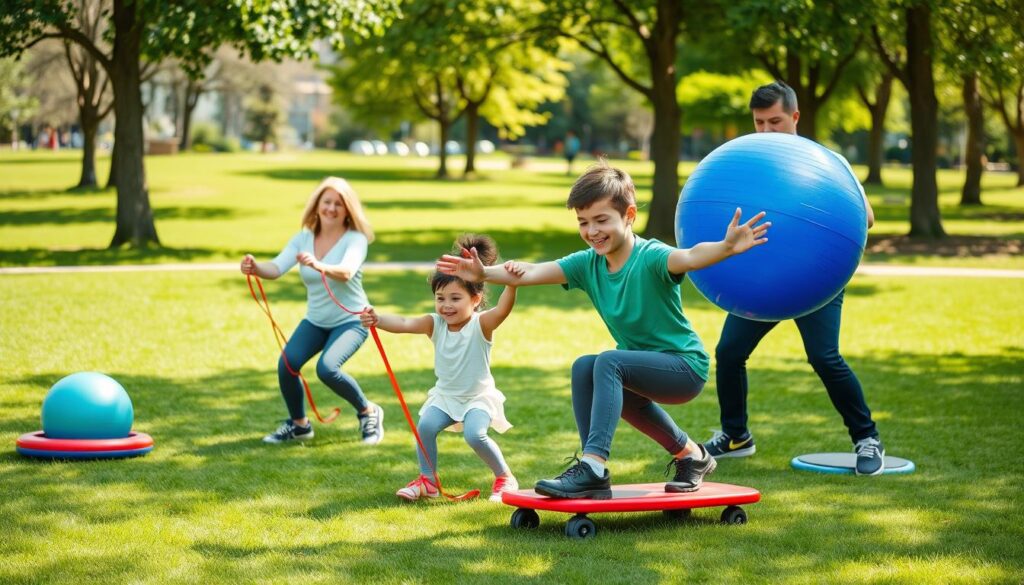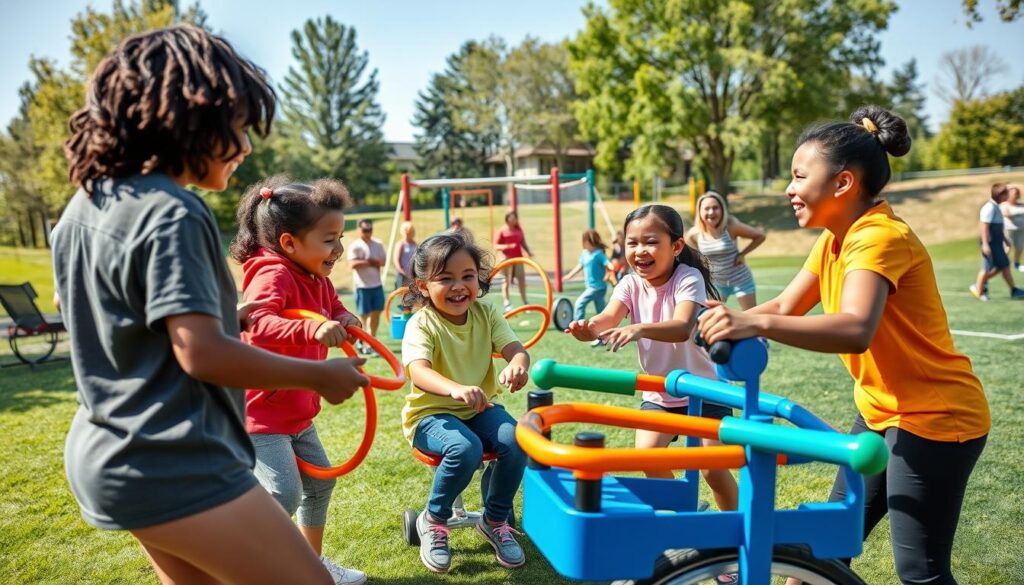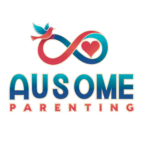Raising a child with autism brings unique challenges and joys. Finding activities we all enjoy together is crucial for our family. Here are some fun, inclusive exercise ideas that have worked well for us.
Physical activity is vital for all children, especially those on the autism spectrum. Kids with autism spectrum disorder (ASD) are 1.5% more likely to be obese1. They often struggle with balance, coordination, and motor planning.
Studies show that exercise can help reduce aggression and repetitive behaviors in children with ASD1. It also improves their focus and decreases elopement tendencies.

Successful autism-friendly exercises cater to your child’s interests and abilities. They should provide necessary sensory-friendly accommodations. Activities like nature walks, music-based exercises, or family workouts can promote inclusive fitness for autism.
Engaging in these activities as a family supports your child’s well-being. It also creates lasting memories and strengthens your bond.
We’ll explore various adaptive physical activities for children with autism, both indoors and outdoors. We’ll also discuss strategies to encourage participation and available resources for families.
Key Takeaways:
- Inclusive family activities promote bonding and support children with autism’s well-being.
- Physical activity improves balance, coordination, and behavior in children with autism.
- Autism-friendly exercises should match the child’s interests and provide sensory-friendly accommodations.
- Indoor and outdoor activities can be adapted for children with autism.
- Encouraging participation in physical activities is crucial for children with autism’s success and enjoyment.
The Importance of Physical Activity for Children with Autism
Physical activity is crucial for children with autism spectrum disorder (ASD). In the U.S., 1 in 5 children aged 2-19 are overweight or obese. Children with ASD have a 1.5% higher chance of obesity2. Regular exercise helps maintain a healthy weight and offers many benefits for autistic children.
Benefits of Exercise for Autistic Children
Exercise improves endurance, strength, and flexibility in children with autism. It also reduces aggressive behaviors and improves on-task behavior and academic responses2. These positive effects can last 40 to 90 minutes after the activity.
Physical activity programs help reduce stress and behavioral problems in autistic children. They also enhance motor coordination, social behavior, and communication skills3. Overall, these programs improve the quality of life for children with ASD.
A 48-week exercise program decreased ASD-related issues in children and teens. It improved social interaction, attention, and emotional control3. It also reduced stereotypical behaviors and sleep disturbances.
Studies show that physical activity boosts social skills in young autistic children and teens. Group play, running programs, and exergaming improve social and communication skills3. Exergaming also enhances balance, coordination, and mobility in autistic children.
Challenges Faced by Autistic Children in Physical Activities
Children with ASD often struggle with balance, coordination, and motor planning. These difficulties may worsen due to lack of physical activity2. Autistic individuals are at higher risk of inactive lifestyles and obesity.
To overcome these challenges, find activities that suit each child’s needs and preferences. This approach encourages regular exercise3. Include short movement breaks throughout the day, like walking, jumping jacks, or dancing.
Consult a pediatric physical therapist or PE teacher for guidance. They can help design appropriate physical activities for children with ASD2. With the right approach, autistic children can enjoy the many benefits of regular exercise.
Choosing the Right Exercises for Your Autistic Child
Selecting activities for autistic kids requires careful thought. Consider their interests, abilities, and sensory needs. With 1 in 36 children diagnosed with autism5, finding engaging exercises is crucial.
Autistic children often struggle with balance, coordination, and motor planning6. Tailoring activities to their strengths and challenges is important. Focus on their individual needs for the best results.
Considering Your Child’s Interests and Abilities
Watch your child’s natural behaviors and favorite pastimes. If they enjoy running, try a treadmill or autism-friendly tracks. Water-loving kids might prefer swimming or aquatic therapy.
Exercise can reduce aggression and repetitive behaviors in autistic children6. Incorporating it into age-appropriate activities works well. This approach makes physical activity more fun and motivating.
Our journey with Idan perfectly illustrates the importance of adapting and persevering when it comes to physical activities for autistic children. Like many parents, we’ve been on a rollercoaster ride trying to find the perfect fit for Idan’s changing needs and preferences.

We started with a subsidized sports class for children with various disabilities. It was a mixed group, including kids with ADHD, muscle weakness, coordination problems, and non-communicative children. At first, Idan thrived. The exercises and games were easy for him, boosting his confidence. But as time went on, the simplicity that initially attracted him became a source of boredom. It was time for a change.
Next, we ventured into a ninja class with neurotypical children Idan’s age. This presented a new challenge – suddenly, Idan found himself struggling to match the physical strength of his peers, particularly in shoulder and arm exercises. But here’s where Idan’s determination shone through. For six months, he attended weekly classes, pushing himself to improve. And improve he did – the progress was remarkable!
However, just as we thought we’d found the perfect activity, a new hurdle appeared. Idan became distressed by the smell of the rings he had to hang from. This sensory issue made it difficult for him to concentrate, eventually leading to his decision to stop attending.
Now, we’re back on the hunt for Idan’s next physical adventure. Despite the challenges, we remain committed to finding a suitable activity because we’ve seen firsthand how sport builds Idan’s confidence and improves his communication skills.
Our experience with Idan underscores several key points:
- Be prepared to try different activities. What works today might not work tomorrow.
- Celebrate improvements, no matter how small.
- Be attuned to your child’s sensory needs – they can make or break an experience.
- Don’t give up. The benefits of physical activity for autistic children are worth the effort of finding the right fit.
Remember, every autistic child is unique. What worked (or didn’t work) for Idan might be completely different for your child. The key is to keep exploring, stay patient, and always keep your child’s interests and comfort at the forefront. With persistence and creativity, you’ll find activities that not only improve physical health but also boost confidence and social skills.
Adapting Activities to Accommodate Sensory Sensitivities
Many autistic children have sensory sensitivities. This can make certain environments challenging. Sensory activities like fidget toys help regulate emotions and focus5.
Adapt the environment and equipment for sensory-friendly sports. The Smart PLAYBALL by PLAYWORK offers sensory stimulation with lights and textures. It provides a comfortable and engaging experience.
Grounding techniques can help autistic children manage sensory overload5. Try counting to ten or focusing on sensory stimuli. Include these in your child’s exercise routine.
Remember, every autistic child is unique. Be patient and experiment with different activities. Keep trying until you find what works best for your family.
Indoor Exercises for Autistic Children
Rainy days can be tough for kids with autism. But don’t worry! There are lots of fun indoor activities to try. These exercises keep children active and happy. They also help with sensory skills and social interaction7.
Yoga and Stretching
Yoga is great for autistic children. It improves flexibility and body awareness. Simple poses like cat-cow are easy to adapt.
Breathing exercises can help reduce stress. They also promote a sense of calm7.
Dancing and Music-Based Activities
Dancing and music are fun ways to get moving indoors. About 1 in 54 children has autism spectrum disorder (ASD)8. Many enjoy sensory input from dancing and music.
Play your child’s favorite songs. Encourage them to move freely. Try games like freeze dance to work on following directions8.
Sensory Play and Obstacle Courses
Sensory play is perfect for indoor exercise. Activities like finger painting help develop fine motor skills. They also stimulate creativity and provide tactile input7.
These activities enhance sensory perception through play. They help autistic children unlock their potential and learn life skills.
Create an indoor obstacle course for fun exercise. Use cushions, tunnels, and hula hoops. Autistic children often enjoy climbing and repetitive movements8.
Structured play supports developmental needs of autistic kids. It builds independence, confidence, and joy in learning.
Outdoor Activities for Children with Autism
Outdoor activities offer many benefits for children with autism. They can explore nature, develop motor skills, and enjoy sensory experiences. Autism-inclusive family fitness has improved my child’s health and brought our family closer.
These activities foster unity and enjoyment for the whole family. Let’s explore some exciting outdoor pursuits tailored for autistic children.
Creating autism-friendly spaces is crucial for outdoor adventures. Choose activities based on the child’s preferences. Establish safe spaces to enhance their overall experience10.
Maintain routines and use simple words or visuals for communication. Prepare sensory tools like headphones or fidget toys. These can help children with ASD feel more comfortable outdoors10.
Involve children in planning to give them control and excitement. This leads to more positive experiences10.
Nature Walks and Hiking
Nature walks and hiking provide a calming environment for children with autism. They can explore at their own pace and observe wildlife. Collecting natural treasures like leaves or rocks can be enjoyable.
Visual schedules showing step-by-step activities help children understand the adventure ahead10. Group outings with other ASD children create a supportive community for everyone10.
Bike Riding and Scootering
Bike riding and scootering improve motor skills and coordination. They offer freedom and independence while providing proprioceptive input. Celebrating achievements boosts confidence and makes future adventures more enjoyable10.
Watch for signs of discomfort and be flexible with plans. This ensures a positive, stress-free experience10.
Water Play and Swimming
Water play and swimming benefit children with autism in many ways. Aquatic therapy develops physical abilities and reduces anxiety. It promotes relaxation in a safe, supportive environment.
Multi-sensory activities like water play boost brain development11. Occupational therapists can design tailored water-based activities for each child11.
| Activity | Benefits | Considerations |
|---|---|---|
| Nature Walks and Hiking | Calming environment, sensory stimulation, exploration at own pace | Use visual schedules, establish safe spaces, involve child in planning |
| Bike Riding and Scootering | Improves motor skills, coordination, and cardiovascular fitness; provides sense of freedom and independence | Celebrate achievements, observe signals for discomfort, be flexible in adjusting plans |
| Water Play and Swimming | Develops physical abilities, reduces anxiety, promotes relaxation; offers multi-sensory stimulation | Engage occupational therapists for tailored activities, prioritize safety, provide supportive environment |
Outdoor activities offer many benefits for children with autism. Nature walks, bike riding, and water play promote family fitness. Create supportive environments and celebrate achievements. Stay flexible to ensure enjoyable experiences for everyone.
Autism-Friendly Exercises for the Whole Family
Family fitness builds strong bonds and supports children with autism. In the U.S., 1 in 54 kids has autism spectrum disorder (ASD)12. It’s crucial to find fun ways to stay active together.
Try taking turns picking favorite sports or activities. This helps everyone find exercises they enjoy. Adaptive swim programs help autistic kids develop physically and improve their senses12.
Outdoor activities like playgrounds and scavenger hunts engage the senses. They also help kids overcome fears and build strengths13.
Daily chores can be great for fitness too. Vacuuming, washing the car, or putting away groceries keep everyone active. These tasks help autistic kids practice motor skills at home.
Kids can gain independence by helping with daily decisions and chores. This also earns them parental approval13.
Parents should join in the fun to make exercise more enjoyable. Your support can motivate your kids to stay active. Try brain breaks, yoga, and movement activities to prepare for daily tasks13.
“Engaging in inclusive fitness activities as a family not only strengthens the bonds between family members but also creates a supportive environment for children with autism.”
Here are some autism-friendly exercises for your family:
- Nature walks and hiking
- Bike riding and scootering
- Water play and swimming
- Dance and music-based activities
- Yoga and stretching
- Obstacle courses and sensory play
Adapt activities to suit sensory needs for a positive experience. The United Center offers a sensory room for guests with disabilities. They provide sensory bags with helpful tools14.
Create a supportive environment to make fitness a regular family routine. This approach helps everyone stay active and healthy.
| Activity | Benefits |
|---|---|
| Yoga | Improves balance, flexibility, and coordination; enhances motor skills development12 |
| Swimming | Develops physical and sensory abilities; contributes to overall well-being12 |
| Outdoor Play | Engages senses; helps overcome fears and weaknesses13 |
| Chores | Keeps family active; practices motor skills; promotes independence13 |
Make fitness a family priority to help autistic children. It builds skills, boosts confidence, and promotes healthier, active lives.
Tools and Equipment to Support Autism-Friendly Exercises
Specialized equipment enhances adaptive activities for autistic children. These tools improve motor skills, coordination, and sensory integration. Age-appropriate gear creates tailored autism exercise programs for each child’s needs15.

Sensory Balls and Trampolines
The Smart PLAYBALL offers a multisensory experience with lights and textures. It encourages tactile exploration and motor skill development. Trampolines provide proprioceptive input and improve balance and coordination16.
Bouncing on trampolines can be fun and engaging. It helps reduce repetitive behaviors in children with ASD16.
Resistance Bands and Weights
Resistance bands and weights build strength in autism exercise programs. They help improve muscle tone and movement coordination. Supervised exercises with these tools provide proprioceptive input15.
Consult a pediatric physical therapist for tailored exercises. They can develop appropriate activities for your child’s needs and abilities16.
Consider your child’s sensory sensitivities when introducing new equipment. Start slowly and offer positive reinforcement. Let your child choose appealing tools to increase motivation16.
With the right tools and support, autistic children can enjoy exercise. They can develop a lifelong love for physical activity and reap its benefits.
Encouraging and Motivating Your Autistic Child to Exercise
Physical activity is vital for autistic children’s development. Kids with ASD may struggle with balance, coordination, and motor planning. Regular exercise can boost endurance, strength, and on-task behavior.
With the right approach, we can help our children enjoy these benefits. Let’s explore effective strategies to motivate autistic kids to exercise.
Setting Achievable Goals and Celebrating Progress
Break activities into smaller, manageable steps. Provide physical or verbal guidance as needed. Acknowledge your child’s efforts and celebrate their successes.
This positive reinforcement builds confidence. It encourages them to keep engaging in physical activities.
Making Exercise Fun and Enjoyable
Incorporate your child’s interests into physical activities. Choose their favorite sports or create an obstacle course together. Children with ASD may respond to different motivators.
Identify what drives your child. This helps them develop a positive association with exercise.
Incorporating Rewards and Positive Reinforcement
Use sticker charts or special rewards to encourage participation. Applied Behavior Analysis often uses extrinsic motivation like favorite foods or activities.
The goal is to transition to intrinsic motivation over time. Gradually reduce external rewards as your child develops positive habits.
| Motivation Technique | Examples | Benefits |
|---|---|---|
| Setting Achievable Goals | Break down activities into smaller steps, provide guidance | Builds confidence, encourages continued engagement |
| Making Exercise Fun | Incorporate interests, create obstacle courses | Develops positive associations with physical activity |
| Positive Reinforcement | Sticker charts, special rewards | Encourages participation, transitions to intrinsic motivation |
These strategies help autistic children develop a love for physical activity. Exercise can decrease aggression, off-task behavior, and repetitive behaviors in kids with ASD17.
Research shows exercise programs can improve academic performance and motor behavior17. As parents, we play a crucial role in encouraging autism-friendly exercises.
By promoting physical activity, we can enhance our children’s overall well-being and quality of life.
Resources for Families Supporting Physical Activity in Autism
Discovering resources for autism-friendly physical activities can be exciting. Local programs, online communities, and professional support offer guidance for your child’s exercise journey. Let’s explore these options to help your child thrive through physical activity.

Local Inclusive Sports Programs and Clubs
Local inclusive sports programs provide great opportunities for autistic children. The Challenger Club offers team sports designed for kids with disabilities18. In Texas, New Strength Adaptive Fitness LLC provides coaching for individuals with various impairments19.
Online Communities and Forums for Parents
Online communities connect parents of autistic children, offering valuable support. These platforms allow parents to share experiences and exchange ideas. You can find local program recommendations and get advice on adapting activities.
Professional Support from Occupational and Physical Therapists
Occupational and physical therapists are crucial in developing suitable exercise programs. They assess your child’s needs and provide tailored activity recommendations. These experts can guide you in adapting activities for sensory sensitivities.
Using these resources creates a holistic approach to engaging your child in physical activity. Joining local clubs, connecting with parents online, and seeking professional guidance ensures access to exercise benefits.
Various activities can support your child’s growth. These include sensory play, outdoor activities, art projects, music, games, and structured physical activities. Technology-based activities, reading, cooking, and animal interaction also promote cognitive and social development20.
Conclusion: Strengthen Family Bonds Through Autism-Friendly Physical Activity
Autism-friendly exercises have transformed my autistic child’s well-being and development. Adaptive activities like resistance tunnel crawling and jump rope sessions improved motor skills and coordination. Sensory-friendly sports enhanced proprioception, social interaction, and stress relief21.
A sensory-safe play zone at home provides a peaceful retreat. Sensory bins and art activities boost fine motor skills and texture tolerance. Yoga exercises tailored for autism improve body awareness and motor skills22.
Nature walks and music enrich our inclusive fitness journey. These activities help with emotional regulation and auditory processing22.
Involving my child in decisions and celebrating progress has been crucial. We seek support from local resources and professionals when needed. Our focus on fun family workouts has created lasting memories.
I urge families with autistic children to try adaptive physical activities. With patience and flexibility, you’ll see amazing growth and happiness in your child. Embrace sensory-friendly activities and witness their incredible impact.
FAQs About Autism, Physical Activity, and Family Fitness
What are some autism-friendly exercises that the whole family can enjoy together?
Autism-friendly family exercises include nature walks, sensory play, and art sessions. Music time, puzzle fun, and animal encounters are also great options. Outdoor games and movie nights allow children to participate comfortably.
Why is exercise important for children with autism spectrum disorder (ASD)?
Exercise is vital for children with ASD due to their higher obesity risk. It improves endurance, strength, and flexibility in autistic children. Regular activity also enhances behavioral skills and reduces disruptive behaviors.
How can I choose the right exercises for my autistic child?
Consider your child’s interests and abilities when choosing exercises. For running lovers, try treadmills or track racing. Swimming is ideal for water-loving kids. Adapt activities to suit sensory needs.
Create a comfortable environment using therapy tools like the Smart PLAYBALL by PLAYWORK. This combines sensory stimulation with physical activity.
What are some indoor exercises that are suitable for autistic children?
Yoga, stretching, and dancing are great indoor exercises for autistic children. Music-based activities, sensory play, and obstacle courses promote fitness and body awareness. Martial arts and dance classes offer structured routines and social interaction opportunities.
What outdoor activities are beneficial for children with autism?
Nature walks, hiking, and bike riding offer numerous benefits for autistic children. Water play and swimming improve motor skills and coordination. Aquatic therapy provides a safe environment for developing physical abilities.
How can I encourage and motivate my autistic child to exercise?
Set achievable goals and celebrate your child’s progress to encourage exercise. Break activities into smaller steps and provide guidance as needed. Make exercise fun by incorporating their interests and preferences.
Use positive reinforcement techniques like sticker charts or special rewards. These keep children engaged and motivated during physical activities.
Where can I find support and resources for autism-friendly physical activities?
Find support through local inclusive sports programs and online communities. Seek professional guidance from occupational and physical therapists. These resources help develop appropriate exercise programs and adapt activities to individual needs.
Connect with other families for shared experiences and support in autism-friendly physical activities.
Source Links
- https://funandfunction.com/blog/exercise-for-kids-with-asd?srsltid=AfmBOooEJbGN8InVFJeXuaJehUbn0ZtyL0rY5VpE9Sa7sxdeAojAGM9N – Exercise for Kids with ASD
- https://funandfunction.com/blog/exercise-for-kids-with-asd?srsltid=AfmBOoq-MIGRxf5ELySAVdDrSpj8KZCkruCg923249HgUKOBPkZRnYeB – Exercise for Kids with ASD
- https://www.abtaba.com/blog/exercises-for-autistic-kids – 5 Important Exercises for Autistic Kids
- https://www.waterford.org/blog/activities-for-children-with-autism/ – 24 Classroom Activities for Kids with Autism | Waterford.org
- https://funandfunction.com/blog/exercise-for-kids-with-asd?srsltid=AfmBOor8kVMCaOb7bC6dFGb5uXVcwdMcdTpE_4a0B6_Kkp–puxMKJoI – Exercise for Kids with ASD
- https://www.bancroft.org/resources/conquering-the-chill-10-engaging-indoor-activities-for-children-with-autism/ – Conquering the Chill: 10 Engaging Indoor Activities for Children with Autism | Bancroft
- https://www.carolynsaunders.com/blog/indoor-activities-perfect-for-autistic-child – 18 Fun Indoor Activities Perfect for Your Autistic Child — Carolyn Saunders
- https://aimhigheraba.com/10-strategies-for-a-stress-free-outdoor-adventure-with-kids-with-asd/ – 10 Tips for a Stress-Free Outdoor Adventure with Kids with ASD
- https://harkla.co/blogs/special-needs/therapeutic-activities-autism?srsltid=AfmBOoqRNv27YAtgCdz2QEXnyaVBxKGDQdPyBgh00-UDhuGJF19vokx3 – 10 Therapeutic Activities for Children with Autism
- https://www.indiaautismcenter.org/unleashing-potential-10-important-exercises-for-autistic-kids/ – Effective Exercises for Autism Let us change the narrative around disability
- https://harkla.co/blogs/special-needs/therapeutic-activities-autism?srsltid=AfmBOorbmdm6xT0BTveVug9tYphEhQ5eL7qPAPlEa_Qvr6E34lC0dl4_ – 10 Therapeutic Activities for Children with Autism
- https://www.choosechicago.com/blog/family/accessible-chicago-autism-friendly-family/ – Activities for Neurodivergent and Autistic Kids in Chicago | Choose Chicago
- https://www.yellowbusaba.com/post/physical-therapy-for-autism – Transforming Lives: The Impact of Physical Therapy for Autism
- https://funandfunction.com/blog/exercise-for-kids-with-asd?srsltid=AfmBOorczjmXw2x9aTslZi_WP97uYxHg_H5c1yUZBapjl9iSvbyUcM90 – Exercise for Kids with ASD
- https://funandfunction.com/blog/exercise-for-kids-with-asd?srsltid=AfmBOors2GYuNIo4xU7uT–FC4CH7F_9apcTe-LlV-ja_ROgPNjouEJJ – Exercise for Kids with ASD
- https://www.verywellhealth.com/best-sports-for-kids-with-autism-260157 – Tips on Sports for a Child Living With Autism
- https://www.belikebuddy.com/texas – Autism-Friendly Activities in Texas
- https://www.shruboak.org/autism-friendly-activities-for-parents-and-caregivers/ – Autism-Friendly Activities for Parents and Caregivers – Shrub Oak International School
- https://www.skillpointtherapy.com/8-fun-home-workouts-for-sensory-smarts/ – 8 Fun Home Workouts for Sensory Smarts
- https://www.mywellnesshub.in/blog/8-engaging-sensory-exercises-for-kids-with-autism/ – 8 Engaging Sensory Exercises for Kids with Autism


